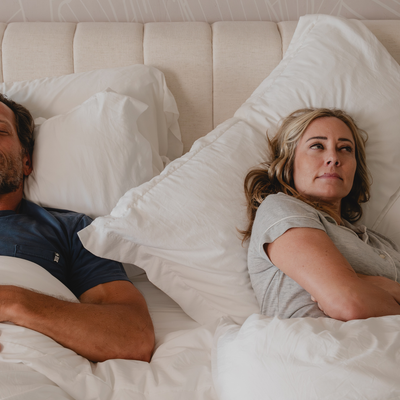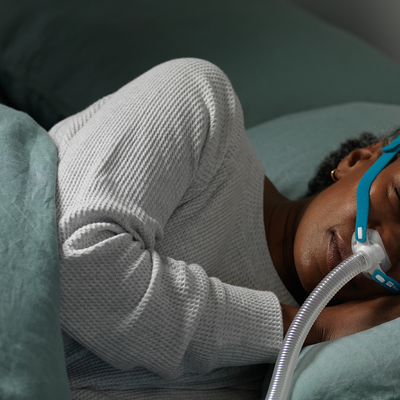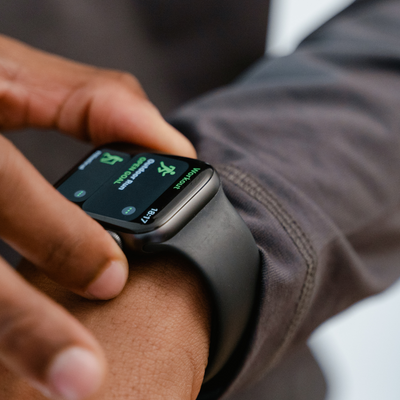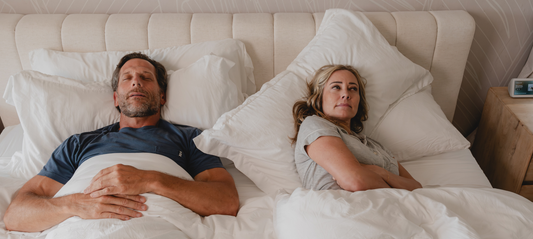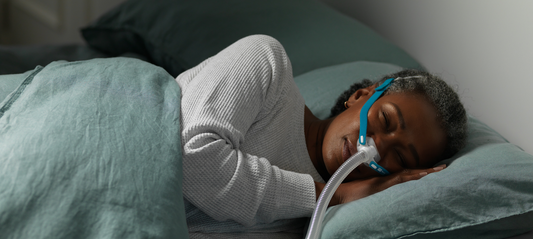Written by Nancy Kirk
February 26, 2024
Learning you have sleep apnea can feel like learning a new language, with all sorts of unfamiliar terms and equipment. So when you first get diagnosed, you may have questions. Luckily, it isn’t as complicated as it may feel at first. Your at-home sleep apnea test records your number of sleep apnea episodes per night. Here’s an overview of what we cover in your test (and what it all means) to help reach a full understanding of your diagnosis.
What is Considered a Sleep Apnea Breathing Event?
When your breathing stops-and-starts for more than 10 seconds, it’s referred to as a sleep apnea event. You can occasionally have a breathing disturbance without being diagnosed with sleep apnea. To be considered sleep apnea, you have to experience at least five sleep apnea events per hour on average throughout your entire sleep duration. A hypopnea event is a period of shallow breathing, which can also contribute to sleep apnea.
Many people use a CPAP machine to lessen their number of breathing events per hour. Before CPAP, you may have had 20+ events per hour. Once you begin treatment, you may have as few as 0.7 events per hour on CPAP.
What is the Apnea-Hypopnea Index?
Your Apnea-Hypopnea Index (AHI) is a way to measure your sleep apnea severity. AHI results can range from 0 to over 100, with higher AHI scores indicating more severe sleep apnea. The AHI measures how often breathing interruptions occur during sleep with a drop in blood oxygen levels during these episodes. A normal AHI is considered to be less than 5 per hour. An AHI score greater than 30 signifies severe sleep apnea.
What Does My AHI Score Mean?
- No Sleep Apnea: Less than 5 AHI
- Mild Sleep Apnea: 5 to 15 AHI
- Moderate Sleep Apnea: 15 to 30 AHI
- Severe Sleep Apnea: Above 30 AHI
Your Lofta Sleep Report
After your at-home sleep apnea test, you’ll receive a report with all your sleep data. This helps you understand your sleep quality and how sleep apnea affects your health. With Lofta, you’re never on your own. You’ll receive a personalized recommendation from one of our doctors, and our team is here to help explain your diagnosis and treatment options each step of the way. Let’s break down your personalized report.
RDI:
The RDI (Respiratory Disturbance Index) shows how many times your sleep test device noticed unusual breathing while you slept. This includes apnea and hypopnea events, as well as other irregular breathing patterns that interrupt your sleep. Some people have a high number of breathing disturbances without as many apnea events. So, even if your AHI is less than 5, you might still be diagnosed with sleep apnea if your RDI is higher, along with other considerations.
Oxygen Saturation:
Oxygen saturation indicates your blood oxygen levels. The baseline for healthy oxygen saturation is 96 to 97%. Because sleep apnea interrupts your breathing, it affects how much oxygen is delivered to your blood stream. This often causes your blood oxygen to drop, causing what’s called oxygen desaturation. This is measured in a percentage, and anything below 95% is cause for concern.
Sleep Pulse:
This measures your heart beats per minute while you sleep. This naturally fluctuates, but sleep apnea increases this variability.
Snoring:
Your sleep apnea test includes data on snoring, like how loud it was (the decibel level), how many minutes you snored, and what percentage of your total sleep time this was. Not all people who snore have sleep apnea, and not all people who have sleep apnea snore. However, it is a common symptom due to a blocked or narrowed airway.
Body Position:
Certain positions, like sleeping on your back, can trigger or worsen sleep apnea. We track each of your sleep positions to help identify your most common sleep positions, and how that may be able to help improve your condition.
Sleep Stages:
There are four main stages of sleep, according to the American Academy of Sleep Medicine. These are two levels of light sleep, plus deep sleep and REM sleep. REM sleep happens intermittently throughout the night, marked by rapid eye movements, increased dreaming, bodily movements, and a faster heart rate and breathing. Sleep apnea typically occurs during deep sleep and REM sleep, when your body is most relaxed.
True Sleep Time:
True sleep time measures how long you sleep, not just how long you’re in bed. For example, you could be in bed for 8+ hours, but your true sleep time may only be 6 hours or even less due to your sleep apnea. One goal of sleep apnea treatment is to increase your true sleep time, so you feel more rested and energized.
Monitoring Your Events Per Hour with CPAP
Your sleep apnea machine should monitor your sleep apnea events per hour to ensure your treatment is working. Ideally, you’ll have below 5 CPAP events per hour, but this could also be as low as 0.3 or even 0 sleep apnea events per hour.
How to Adjust Your CPAP Machine
If you’re concerned that you’re still having too many sleep apnea events and breathing disruptions per hour, reach out to one of our dedicated team members. It’s not recommended that you adjust your CPAP machine on your own without a prescription. However, we do have Auto Adjusting CPAP machines which adjust pressure on a breath-by-breath basis. It’s best to speak with a professional if you feel something isn’t right. The Lofta team is here to help you unlock better, more restful sleep.
Have Questions? Reach out to Lofta today.
Our team of dedicated sleep experts is here to help along your sleep apnea journey to better health. Whether you’re unsure about what CPAP is best for you, or have a question about your sleep report, we’re here to answer all your questions.
Phone: 1-800-698-8000
Email: sleep@lofta.com



